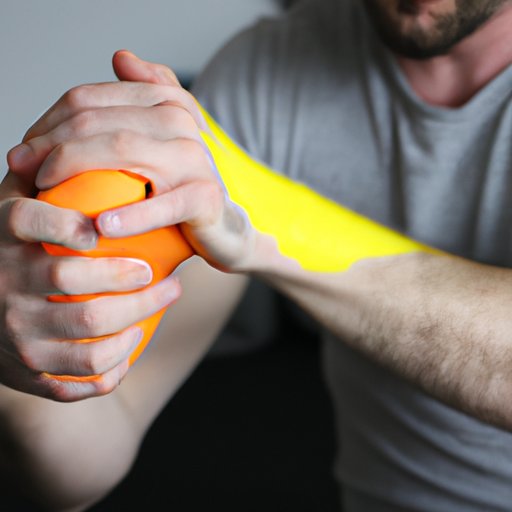
I. Introduction
Have you ever felt a sudden sharp pain while participating in a physical activity? Or perhaps you’ve woken up with a stiff and sore muscle after a long day at work? If so, there’s a chance that you may have experienced a pulled muscle. In this article, we will provide you with essential information on how to treat a pulled muscle and prevent future injuries. By reading on, you’ll discover various treatment options, stretching techniques, pain management strategies, potential complications, and helpful tips for preventing future injuries.
II. Overview of Pulled Muscles
Pulled muscles, also known as muscle strains, occur when muscle fibers are stretched beyond their limit or torn. They are commonly caused by physical activity, especially if they are sudden and require quick movements. Other risk factors include improper lifting, poor flexibility, and weak muscles.
Common signs and symptoms of a pulled muscle include:
- Pain in the affected muscle and surrounding area.
- Stiffness and difficulty moving the affected muscle.
- Swelling, bruising, or redness in the affected area.
III. Common Treatment Options for Pulled Muscles
If you are experiencing a pulled muscle, the best way to start the healing process is by following the RICE method: rest, ice, compression, and elevation. Rest the affected muscle to prevent further damage and promote healing. Apply ice to the affected area to reduce swelling and numb pain. Use compression bandages to limit swelling and provide support. Elevate the affected area above heart level to encourage proper blood flow and reduce swelling.
Although the RICE method is the most commonly recommended treatment, there are other options to consider. Physical therapy can help with healing and prevent further injuries. Massage therapy can help reduce pain and improve muscle flexibility. However, it is crucial to discuss these options with a healthcare professional before resorting to them, as they may not be suitable for everyone.
IV. Stretching and Exercises for Pulled Muscles
Gentle stretching of the affected muscle is an essential step in the recovery process. Stretching can improve the flexibility of the muscle and prevent scar tissue from forming. Some recommended stretches include:
- Hamstring stretch: Sit on the floor with your legs straight in front of you. Reach forward with your arms and try to touch your toes. Hold for 30 seconds, then release.
- Quad stretch: Stand with your feet together and lift your right foot off the ground. Hold your right ankle with your right hand and pull it towards your buttocks. Hold for 30 seconds, then release and repeat on the other side.
- Calf stretch: Stand with your hands on a wall and step your right foot back. Keep your right heel down and push your right hip towards the wall. Hold for 30 seconds, then release and repeat on the other side.
In addition to stretches, exercises can help rebuild the strength of the affected muscle. Examples of exercises to consider include bodyweight squats, lunges, and step-ups. However, it is essential to start with low-intensity exercises and gradually increase the intensity as your muscle begins to heal.
V. Pain and Discomfort Management for Pulled Muscles
Over-the-counter pain relief options such as ibuprofen and acetaminophen can help manage the pain associated with a pulled muscle. However, it is crucial to read the labels carefully and take medication as directed. Overdosing can cause severe liver damage or gastrointestinal issues.
It is also essential to build healthy lifestyle habits to recover faster and better. Getting enough sleep, reducing stress, and eating nutritious food can improve muscle healing and reduce the risk of future injuries.
VI. Potential Complications of Untreated Pulled Muscles
If left untreated, pulled muscles can lead to potential complications such as chronic pain, muscle weakness, and scarring. The initial pain and swelling may subside, but if proper healing does not occur, it can lead to long-term pain and weakness.
It is essential to compare the short-term pain relief from untreated muscles to the long-term consequences of ignoring treatment. Seeking treatment early can lead to a faster and more complete recovery.
VII. Tips for Preventing Pulled Muscles
Preventing pulled muscles is crucial to avoid future injuries. Proper warm-up techniques can help prepare your muscles before physical activity. Some essential warm-up exercises include jogging, jumping jacks, or dynamic stretching. It can help increase blood flow and muscle flexibility.
In addition to warming up, maintaining good posture throughout the day can help prevent pulled muscles. Taking breaks and moving around every hour or so can also reduce the risk of muscle strain.
VIII. Conclusion
If you ever experience a pulled muscle, the first step is to follow the RICE method. Pain and swelling can be managed through physical therapy, massage therapy or over-the-counter medication. Proper stretching and exercises can help rebuild the strength of the affected muscle. Seeking treatment early can lead to a faster and more complete recovery. Finally, maintaining healthy habits such as warm-up exercise and good posture can reduce the risk of future injuries. Remember, taking care of your muscles is essential, and seeking professional medical advice before engaging in any treatment is always recommended.




